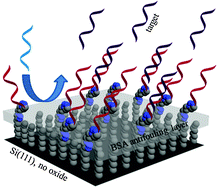A robust DNA interface on a silicon electrode†
Abstract
Two different interfaces prepared via UV-hydrosilylation of undecylenic acid and 1,8-nonadiyne on silicon(111) have been explored to develop a robust electrochemical DNA sensor. Electrodes modified with undecylenic acid were found to stably immobilise DNA but could not resist the growth of insulating oxides, whereas 1,8-nonadiyne modified electrodes satisfy both requirements.


 Please wait while we load your content...
Please wait while we load your content...